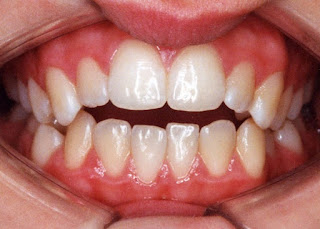Definitions
Anterior open bite: there is no
vertical overlap of the incisors when the buccal segment teeth are in
occlusion.
Aetiology
of anterior open bite
In common with other types of
malocclusion, both inherited and environmental factors are implicated in the
aetiology of anterior open bite. These factor include skeletal pattern, soft
tissues, habits, and localized failure of development.
Skeletal
pattern
Individual with a tendency to
vertical rather than horizontal facial growth exhibit increased vertical
skeletal proportions. Where the lower face height is increased there will be an
increased inter-occlusal distance
between the maxilla and mandible. Although the labial segment teeth appear to
be able to compensate for this to a limited extent by further eruption, where
the inter-occlusal distance exceeds this compensatory ability an anterior open
bite will result. If the vertical, downwards and backwards pattern of growth
continues, the anterior open bite will become more marked.
In this group of patients the
anterior open bite is usually symmetrical and in the more severe cases may
extend distally around the arch so that only the posterior molars are in
contact when the patient is in maximal interdigitation. The vertical
development of the labial segments results in typically extended alveolar
processes when viewed on a lateral cephalometric radiograph.
Soft
tissue pattern
In order to be able to swallow it
is necessary to create an anterior oral seal. In younger children the lips are
often incompetent and a proportion will achieve an anterior seal by positioning
their tongue forward between the anterior teeth during swallowing. Individuals
with increased vertical skeletal proportions have an increased likelihood of
incompetent lips and may continue to achieve an anterior oral seal in this
manner even when the soft tissues have matured. This type of swallowing pattern
is also seen in patients with an anterior open bite due to a digit-sucking
habit. In these situations the behaviour of the tongue is adaptive. An
endogenous or primary tongue thrust is rare, but it is difficult to distinguish
it from an adaptive tongue thrust as the occlusal features are similar.
However, it has been suggested that an endogenous tongue thrust is associated
with stigmatism (lisping), and in some cases both the upper and lower incisors
are proclined by the action of the tongue.
Habits
The effects of a habit depend
upon its duration and intensity. If a persistent digit-sucking habit continues
into the mixed and permanent dentitions, this can result in an anterior open
bite due to restriction of development of the incisors by the finger or thumb.
Char-acteristically, the anterior open bite produced is asymmetrical (unless
the patient sucks two fingers) and it is often associated with a posterior
crossbite. Constriction of the upper arch is believed to be caused by cheek
pressure and a low tongue position.
After a sucking habit stops the
open bite tends to resolve, although this may take several months. During this
period the tongue may come forward during swallowing to achieve an anterior
seal. In a small proportion of cases where the habit has continued until growth
is complete the open bite may persist.
Localized
failure of development

Tidak ada komentar:
Posting Komentar